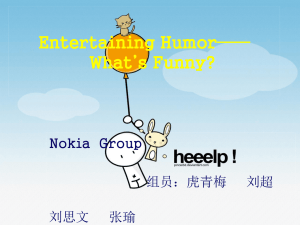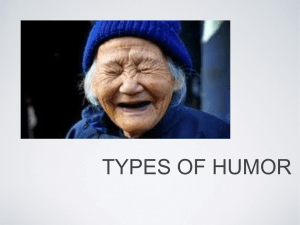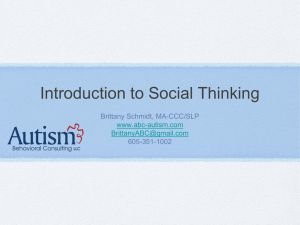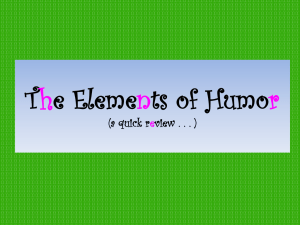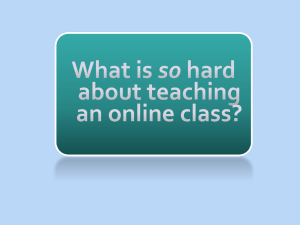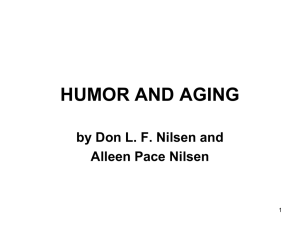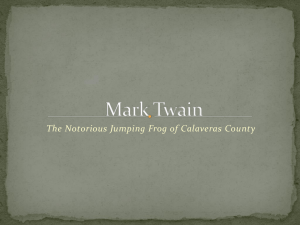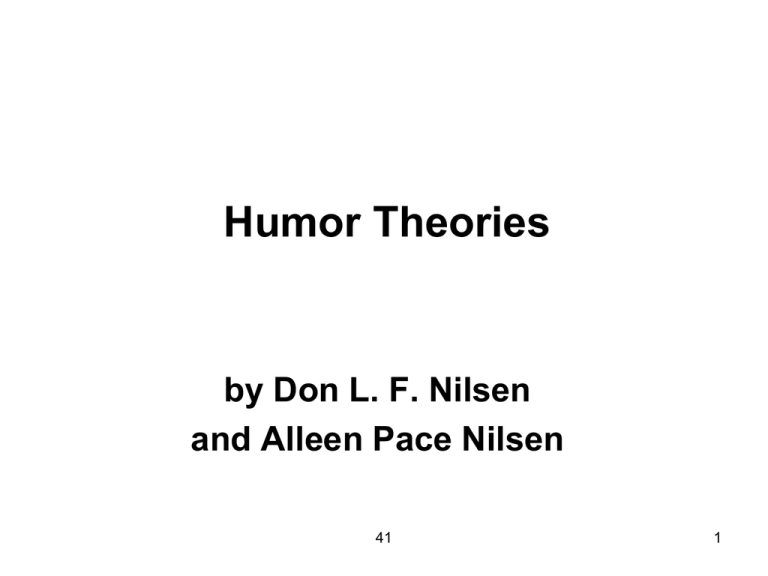
Humor Theories
by Don L. F. Nilsen
and Alleen Pace Nilsen
41
1
Victor Raskin’s Tripartite Classification
INCONGRUITY HOSTILITY
RELEASE
Contrast
Incongruity
Resolution
Sublimation
Liberation
Economy
Aggression
Superiority
Triumph
Derision
Disparagement
41
(Attardo [2007], 103)
2
Script-Model Grammar
• Raskin’s 1985 Semantic-Script Theory of Humor
(SSTH) sees humor as a violation of Grice’s
cooperative principle.
• A joke consists of two overlapping scripts.
• The two scripts are in opposition (bona-fide vs.
scatalogical)
• The punch line changes the joke from the bona-fide
to the scatalogical script.
(Attardo [2007] 108)
41
3
Overlapping Scripts
• Overlapping scripts occur not only in jokes, but also
in the allegory, the oxymoron, the conceit, the simile,
and perhaps in all allusion, symbolism, double
entendre and intertextuality.
• Overlapping scripts also occur in the master tropes-metaphor, metonymy, synecdoche, and irony.
• And for all of these literary forms, there is the bonafide (or literal) script, and the non-bona-fide (or
figurative) script.
(Triezenberg [2008]: 536)
41
4
Humor Enhancers
• Katrina Triezenberg notes that humorous
discourse also has humor enhancers.
• “A humor enhancer is a narrative technique
that is not necessarily funny in and of itself,
but that helps the audience to understand
that the text is supposed to be funny, that
warms them up to the author and to the text
so that they will be more receptive to humor,
and that magnifies their experience of humor
in the text.”
(Triezenberg [2008]: 537-538)
41
5
• These humor enhancers allow a piece of
humor to be instantaneous and
epiphinal. They include:
– Shared stereotypes,
– Cultural factors (prejudices, hang-ups,
taboos, etc.),
– Familiarity (as with a good impersonation,
or as with something that is “spot-on”), and
– Repetition and variation
(Triezenberg [2008]: 539)
41
6
Why Mysteries Are Not Funny
• Jokes and lies both violate Grice’s “Conversational
Implicatures.” They are both examples of “nonbona-fide communication.”
• In murder mysteries, the reader is often led down the
garden path, and given false clues.
• To solve the mystery, the reader has to consider
script oppositions to determine if scripts are not
compatible with each other, and if not, why not.
(Triezenberg [2008]: 540)
41
7
General Theory of Verbal Humor (GTVH)
1.
Script Opposition
2.
Incongruity & Resolution
3.
Situation (including props)
4.
Target (butt of the joke)
5.
Genre (joke, riddle, etc.)
6.
Language (compatible with both scripts)
(Attardo [2007] 108)
41
8
Jab Lines vs. Punch Lines
• Jab lines are tendentious, but punch
lines are not.
• “Whereas punch lines are disruptive of
the narrative they close, jab lines are
not, and in fact often contribute to the
development of the text.”
(Attardo [2007] 110).
41
9
Salvatore Attardo’s Hierarchy
• Lines that are related form a strand.
• A bunch of related strands is called a stack.
• A bridge is the occurrence of two related
lines far from each other.
• A comb is the occurrence of several related
lines in close proximity.
(Attardo [2007] 111)
41
10
Attardo’s Defining Moment
• “Each story that is not a picaresque story
has a central defining event in the plot that
sets the wheels in motion:
• Madame Bovary’s adultery
• Raskolnikoff’s homicide
• Lolita’s seduction, etc.”
(Attardo [2007] 113)
41
11
Sigmund Freud
• “Sigmund Freud distinguishes between
innocent and tendentious jokes.”
(Attardo [2007], 104).
• RIDDLE: What do you get when you cross a
mafioso with a postmodern theorist?
• ANSWER: Someone who will make you an
offer you cannot understand.”
(Attardo [2007] 109)
41
12
Humor Sophistication
• Victor Raskin notes that sophistication
in humor is similar to sophistication
more generally, and that it entails:
• Rarity, expensiveness, availability,
complexity, exoticness, subtlety,
refinement, obscurity, prestigiousness,
desirability, unexpectedness, etc.
(Raskin [2008]) 12)
41
13
Sophistication via Innuendo
• When I was young I helped a good fairy in distress,
so she offered me a choice, an excellent memory or
a large penis.
• I do not recall what I chose.
• NOTE: “Fewer and fewer people ‘get’ the jokes as
sophistication increases.”
• “Perhaps sophistication correlates with the number
of missing links in inferencing.”
(Raskin [2008] 13)
41
14
Ranking of Humor
Sophistication
• 1. He was a man of letters. He worked at the Post
Office.
• 2. I am very unhappy. I have two girlfriends, and
both are cheating on me.
• 3-9. No Examples Given
• 10. What’s the difference between the sparrow? No
difference whatsoever. Both halves are identical,
especially the left one.
(Raskin [2008] 13)
41
15
Superiority Theory & Humor
Neither a Necessary nor a Sufficient Condition
• When we see a Charlie Chaplin movie, do we
feel superior to Charlie Chaplin.
• John Morreall feels that we laugh “at the
clever and acrobatic way Charlie Chaplin
gets out of a tough situation.”
• Morreall also notes that if we win a race, we
feel superior to the losers, but humor does
not automatically result from winning.
(Morreall [2008] 233)
41
16
Discuss the following:
Humor is hostile
Humor diminishes
self-control.
Humor is irresponsible
41
17
Discuss the following:
•
•
•
•
•
•
•
•
•
Humor is hostile
Humor diminishes self-control.
Humor is irresponsible.
Humor is insincere.
Humor is idle.
Humor is hedonistic.
Humor fosters sexual license.
Humor fosters anarchy.
Humor is foolish.
(Morreall [2008] 237-238)
41
18
HUMOR THEORIES
• THE EVOLUTION THEORIES as proposed by Charles Darwin, and
by the I. A. H. B.
• THE HUMOR-IS-GOOD-FOR-YOU THEORIES as proposed by
Norman Cousins, et. al.
• THE SUPERIORITY THEORIES as proposed by Aristotle, Plato,
Thomas Hobbes, Henri Bergson, and Charles Gruner
• THE INCONGRUITY THEORIES as proposed by Immanuel Kant,
Arthur Shopenhauer, Paul McGhee and John Morreall
• THE SURPRISE THEORIES as proposed by René Descartes
41
19
• THE AMBIVALENCE THEORIES (FEELINGS
AND EMOTIONS) as proposed by Socrates
• THE CONFIGURATIONAL THEORIES
(GESTALT RECOGNITION AND SUDDEN
INSIGHT) as proposed by G. W. F. Hegel
• THE PSYCHOANALYTIC THEORIES as
proposed by Sigmund Freud
• THE RELEASE AND RELIEF THEORIES as
proposed by Harvey Mindess and William Fry
41
20
A NEW WAY OF LOOKING AT
HUMOR THEORIES:
• FEATURES
• FUNCTIONS
• SUBJECTS
41
21
FEATURES OF HUMOR:
INCONGRUITY AND
INCONGRUITY RESULUTION
Unresolved
Resolved
41
22
FEATURES OF HUMOR:
SURPRISE AND TENSION
• Surprise
– Garden Path
– Epiphany
• Tension and Relief
41
23
ALLEEN NILSEN’S FEATURES OF HUMOR
•
•
•
•
•
•
•
•
•
•
•
Ambiguity
Exaggeration
Understatement
Hostility
Incongruity or Irony
Situation-Insight
Sudden Insight
Superiority
Surprise or Shock
A Trick or Twist
Word Play
(A. Nilsen Living Language 202-203)
41
24
EXPLAIN THE FEATURES
IN THE FOLLOWING JOKES:
• David Letterman’s first job in broadcasting was at
Ball State University’s classical music radio station,
WBST. He was a constant trial to Tom Watson, the
manager, who in exasperation fired him after he
introduced the song “Clair de Lune” with “You know
the de Lune sisters; there was Claire; there was
Mabel….”
• Word Play
(A. Nilsen Living Language 204)
41
25
• Left to our own devices, we
Wobegonians go straight for the small
potatoes.
• Majestic doesn’t appeal to us; we like
the Grand Canyon better with Clarence
and Arlene parked in front of it smiling.
• Understatement
(Nilsen & Nilsen Encyclopedia 301)
41
26
• Will Rogers solemnly declared, “They
have an unwritten law in the Senate
that a new member is not allowed to
say anything when he first gets in, and
another unwritten law that whatever he
says afterward is not to amount to
anything.”
• Superiority
(A. Nilsen Living Language 205)
41
27
• A good man dies and goes to heaven. When
St. Peter asks him if there’s anything he can
do for him, the man explains that he would
love to talk to Mary, the mother of Jesus. St.
Peter is happy to set up such a meeting.
After a few polite formalities, the man tells
Mary the purpose of his request. He has
always wanted to ask her something.
• When she encourages him to go ahead, he
says, “I’ve wondered why in all your pictures
you look so sad. Please tell me what it is.”
Mary sighs and then with a little wistful smile
confesses, “I always wanted a daughter.
• Incongruity and Surprise
(A. Nilsen Living Language 205)
41
28
• In one of her routines, eleven-year-old Claire
Friedman told about a classmate she calls
Tiffany: “During lunch, Tiffany was staring at
her carton of orange juice. I asked why. She
said, “The box says concentrate.”
• Claire said, “Tiffany is so dumb she’d get
fired from an M&M factory for throwing away
all the Ws.
• Superiority, Hostility, Wordplay
(A. Nilsen Living Language 204)
41
29
• During the 1960s, there was talk of nominating
Senator Margaret Chase Smith for President of the
United States. One reporter stuck a microphone in
her face and asked, “Mrs. Smith, what would you do
if you should wake up some morning and find
yourself in the White House?”
• Without batting an eye she responded, “I would go to
the president’s wife, apologize, and leave
immediately.”
• Situation, Surprise,etc.
(A. Nilsen Living Language 204)
41
30
• A four-year-old was brought to the emergency room
of a hospital with a bad cough.
• The child kept up a nonstop conversation while the
nurse was trying to assess her lung sounds. Finally,
the nurse said, “Shhh, I have to see if Barney is in
there.” The child looked at her and calmly stated, “I
have Jesus in my heart. Barney is on my
underwear.”
• Surprise, Incongruity, etc.
(A. Nilsen Living Language 204)
41
31
• At the opening of a new play, George
Bernard Shaw sent two tickets to Winston
Churchill. Shaw wrote on the letter, “Here is
a ticket for you and your friend—if you have
one.”
• Churchill sent back the tickets with a
message for Shaw. “I can’t attend on the
opening night, but I would love to go to the
second performance—if you have one.”
• Hostility, Exaggeration, Word Play, etc.
(A. Nilsen Living Language 204)
41
32
• In Alice in Wonderland, the Mock Turtle
explains to Alice that he “only took the
regular course.” “What was that?” inquired
Alice. “Reeling and Writhing, of course, to
begin with, and then the different branches
of Arithmetic—Ambition, Distraction,
Uglification, and Derision.”
• Word Play, etc.
(A. Nilsen Living Language 205)
41
33
Literary Functions of Humor:
Scripts and Double Entendre
• “The text of a joke is always fully or in part
compatible with two distinct scripts and the
two scripts are opposed to each other in a
special way.”
• “The punchline triggers the switch from the
one script to the other by making the hearer
backtrack and realize that a different
interpretation [of the joke] was possible from
the very beginning.”
(Attardo and Raskin [1991] 308)
41
34
PSYCHOLOGICAL
FUNCTIONS OF HUMOR
–
–
–
–
–
–
–
–
Arousal
Social Control
Establishment of Superiority
Relief, and Release
Ego Defense, Coping, and Saving Face
Gaining Status
Healing
Testing Limits
41
35
SELF-DISPARAGEMENT
• Self-disparagement humor is actually
intended to empower the user. Here are
some effective ads using selfdisparagement:
• Terminix Pest Control: “When you think of
pests, think of us.
• Twist Lemon-Menthol Cigarettes: “Our new
menthol is a lemon.”
41
36
• Champion International Trend Carpet: “Eight
million people walked all over us. And they
don’t even know our name.”
• Quaker Oats as a diet food: “Quaker Oats:
Breakfast of losers.”
• Simmons bunk beds: “Simmons beds are a
lot of bunk.”
(Nilsen & Nilsen 273)
41
37
EDUCATIONAL
FUNCTIONS OF HUMOR
– Teaching and Learning
– Arguing and Persuading
41
38
SOCIAL FUNCTIONS OF HUMOR
– In-Bonding and Out-Bonding
– Promoting Social Stability and Control
– Promoting Social Change
41
39
SUPERIORITY VS. INCONGRUITY
• In Reflections upon Laughter, Frances Hutcheson argued
against Thomas Hobbes’s century-old superiority theory.
• He pointed out that people don’t go to asylums to laugh at the
“inferior” beings, nor do we laugh at animals unless they
resemble human beings.
• We laugh at someone who slips on a banana peel not because
we feel superior, but because of the incongruity between our
expectations and the sudden insight.
(Nilsen & Nilsen 163)
41
40
!SUBJECTS OF HUMOR
– Ethnic Identification
– Politics
– Sexual Roles and Scatology
– Occupations
– Religion and Belief Systems
41
41
• !!OLD TABOOS AND CENSORSHIP
• These are the taboo areas in American
English. They’re the subjects that we can’t
talk about, but we must talk about.
• But these taboos are changing. Most of our
censorship used to come from the right, but
now our censorship is coming from both the
right and the left. Censorship from the left is
called “political correctness.”
41
42
• !!!NEW TABOOS AND CENSORSHIP
• TABOO AND CENSORSHIP FROM THE RIGHT
INCLUDES:
– Sex, Religion, Body Parts, Swear Words, Obscenities
and Vulgarities
• TABOO AND CENSORSHIP FROM THE LEFT
(POLITICAL CORRECTNESS) INCLUDES:
– Women, Gays, Disabled People, Ethnic Minorities and
Old People
41
43
HUMOR WEB SITES
AMERICAN COMEDY ARCHIVES (JENNI MATZ):
www.emerson.edu/comedy
THE ASSOCIATION FOR THE STUDY OF PLAY:
http://www.tasplay.org
COMEDY ARCHIVES (JENNI MATZ):
http://www.greaterboston.tv/features/gb_20060509_comedy.html
COMEDY USA (BARRY WEINTRAUB):
www.comedyusa.com
THE HUMOR COLLECTION (RUTH HAMILTON):
www.thehumorcollection.org
41
44
HUMOR MATTERS (STEVE SULTANOFF):
http://www.humormatters.com
THE HUMOR PROJECT (JOEL GOODMAN):
www.HumorProject.com
INTERNATIONAL SOCIETY OF HUMOR
STUDIES (MARTIN LAMPERT):
www.humorstudies.org
ISHS HISTORICAL SITE (DON NILSEN):
http://www.uniduesseldorf.de/WWW/MathNat/Ruch/Secretar
yPage.html
41
45
LAUGHING JAPAN (TILL WEINGAERTNER):
http://www.tillchan.typepad.com/laughing
MIRTH: HUMOR AND LAUGHTER IN TEACHING (RON BERK):
www.mirthium.com
PARENTING HUMOR (TIM BETE):
http://www.TimBete.com
A PLAYFUL PATH TO WHOLENESS (BERNIE DEKOVEN):
http://www.deepfun.com
SNIGLETS (RICH HALL):
http://www.ziplink.net/users/wood/funny/snigglets.html
41
46
References:
Apter, Michael J. “Humour and Reversal Theory.” Chapter 8 in Michael
Apter’s The Experience of Motivation: The Theory of Psychological
Reversals. New York, NY: Academic Press, 1982.
Apter, Michael J., and Kenneth C. P. Smith. “Humour and the Theory of
Psychological Reversals.” in Chapman and Foot (1977): 95-100.
Attardo, Salvatore. “The General Theory of Verbal Humor, Twenty Years
After.” HUMOR: International Journal of Humor Research 24-2 (2011):
123.
Attardo, Salvatore. Linguistic Theories of Humor. Berlin, Germany: Walter
de Gruyter, 1994.
Attardo, Salvatore. “A Multiple-Level Analysis of Jokes.” HUMOR:
International Journal of Humor Research 2.4 (438-439).
41
47
Attardo, Salvatore. “A Primer for the Linguistics of Humor” in Raskin
2007, 101-156.
Attardo, Salvatore, and Lucy Pickering. “Timing in the Performance of
Jokes.” HUMOR: International Journal of Humor Research 24.2 (2011):
233-250.
Attardo, Salvatore, and Victor Raskin. “Script Theory Revis(it)ed: Joke
Similarity and Joke Representation Model.” HUMOR: International Journal
of Humor Research 4.3-4 (1991): 293-347.
Beeman, William O. “Humor.” Journal of Linguistic Anthropology 9.2
(2000): 1-4.
Bell, Nancy D., Scott Crossley, and Christian F. Hempelmann. “Wordplay
in Church Marquees.” HUMOR: International Journal of Humor Research
24.2 (2011): 187-202.
41
48
Berger, Arthur Asa. An Anatomy of Humor. Paperback: Edison, NJ:
Transaction Publishers, 1999.
Berger, Arthur Asa. Blind Men and Elephants: Perspectives on Humor.
Paperback: Edison, NJ: Transaction Publishers, 2010.
Berger, Arthur Asa. “Humor: An Introduction.” American Behavioral
Scientist 30.3 (1987): 6-16.
Boskin, Joseph. Humor and Social Change in 20th Century America.
Boston, MA: Boston Public Library, 1979.
41
49
Boskin, Joeph, ed. The Humor Prism in 20th-Century America. Detroit, MI:
Wayne State University Press, 1997.
Cann, Arnie, and Katherine C. Etzel. “Remembering and Anticipating
Stressors: Positive Personality Mediates the Relationship with Sense
of Humor.” HUMOR 21.2 (2008): 157-178.
Chafe, Wallace L. The Importance of Not Being Earnest: The Feeling
Behind Laughter and Humor. Amsterdam, Netherlands: John
Benjamins, 2007.
Chapman, Anthony, and Hugh Foot, eds. It’s a Funny Thing, Humour.
Oxford, England: Pergamon Press, 1977.
Chapman, Anthony, and Hugh Foot, eds. Humor and Laughter: Theory,
Research, and Applications. Paperback: Edison, NJ: Transaction
Publishers, 1995.
41
50
Davies, Christie. “Logical Mechanisms: A Critique.” HUMOR: International
Journal of Humor Research 24.2 (2011): 159-166.
Deckers, Lambert. “On the Validity of a Weight-Judging Paradigm for the
Study of Humor.” HUMOR: International Journal of Humor Research 6.1
(1993): 43-56.
Doloff, Steven. “Racism and the Risks of Ethnic Humor” (Eschholz 273275).
Eckardt, A. Roy. How to Tell God from the Devil. Edison, NJ: Transaction,
1995.
Eckardt, A. Roy. On the Way to Death: Essays Toward a Comic Vision.
Edison, NJ: Transaction, 1995.
Eckardt, A. Roy. Sitting in the Earth and Laughing: A Handbook of Humor.
Edison, NJ: Transaction, 1991.
Eschholz, Paul, Alfred Rosa, and Virginia Clark. “The Power of the Mass
Media.” Language Awareness: Readings for College Writers, 10th
Edition. Boston, MA: Bedford/St. Martin’s, 2009.
41
51
Farb, Peter. “Speaking Seriously about Humor.” The Massachusetts
Review 22.4 (1981): 760-776.
Ferguson, Mark A., and Thomas E. Ford. “Disparagement Humor: A
Theoretical and Empirical review of Psychoanalytic, Superiority, and
Social Identity Theories.” HUMOR 21.3 (2008): 283-312.
Fleet, F. R. A Theory of Wit and Humour. Port Washington, NY: Kennikat
Press, 1970.
Frewen, Paul A., Jaylene Brinker, Rod A. Martin, and David J. A. Dozois.
“Humor Styles and Personality-Vulnerability to Depression.” HUMOR 21.2
(2008): 179-196.
41
52
Fry, William F. Sweet Madness: A Study of Humor. Palo Alto, CA:
Pacific Books, 1963.
Fry, William F., and Waleed Salameh, eds. Advances in Humor and
Psychotherapy. Sarasota, FL: Professional Resource Press,
1993.
Fry, William F., and Waleed Salameh. Handbook of Humor and
Psychotherapy. Sarasota, FL: Professional Resources
Exchange, 1987.
Galloway, Graeme. “Humor and Ad Liking: Evidence that
Sensation Seeking Moderates the Effects of IncongruityResolution Humor.” Psychology and Marketing 26.9 (2009):
779-792.
41
53
Galloway, Graeme and Danielle Chirico. “Personality and Humor
Appreciation: Evidence of an Association between Trait Neuroticism
and Preferences for Structural Features of Humor.” HUMOR 21.2
(2008): 129-142.
Grotjahn, Martin. Beyond Laughter. New York, NY: McGraw Hill, 1957.
Gruner, Charles R. The Game of Humor: A Comprehensive Theory of Why
We Laugh. Paperback: Edison, NJ: Transaction Publishers, 1999.
Gruner, Charles. Understanding Laughter: The Workings of Wit and
Humor. Chicago, IL: Nelson-Hall, 1978.
Hartz, Glenn A., and Ralph Hunt. “Humor: The Beauty and the Beast.”
American Philosophical Quarterly 28.4 (1991): 299-309.
41
54
Hempelmann, Christian F., and Salvatore Attardo. “Resolutions and Their
Incongruities: Further Thoughts on Logical Mechanisms.” HUMOR:
International Journal of Humor Research 24-2 (2011):
Hirt, Michael, and Judy Genshaft. “The Effects of Incongruity and
Complexity on the Perception of Humor.” Personality and Individual
Differences 3 (1982): 453-455.
Jones, James M. “Cognitive Factors in the Appreciation of Humor: A
Theoretical and Experimental Analysis. Unpublished Ph.D. Dissertation,
New Haven, CT: Yale University, 1970.
Kerr, Walter. Tragedy and Comedy New York, NY: Simon and Schuster,
1967.
41
55
Kilbourne, Edwin D. “Humor in Science.” Proceedings of the
American Philosophical Society 140-3 (1996): 338-349.
LaFave, Lawrence. “Humor Judgments as a Function of Reference
Groups and Identification Classes.” in Goldstein and McGhee
(1972): 195-210.
LaFave, Lawrence. “Superiority, Enhanced Self-Esteem and
Perceived Incongruity Humor Theory.” in Chapman and Foot
(1976): 63-92.
Lauter, Paul, ed. Theories of Comedy. New York, NY: Doubleday
Anchor, 1969.
McGhee, Paul E., and Jeffrey Goldstein, eds. Handbook of Humor
Research. New York, NY: Springer-Verlag, 1983.
41
56
MacHovec, Frank J. Humor: Theory, History, Applications.
Springfield, IL: C. C. Thomas, 1988.
Martin, G. Neil, Sharon J. Sadler, Clare E. Barrett, and Alison
Beaven. “Measuring Responses to Humor: How the Testing
Context Affects Individuals’ Reaction to Comedy.” HUMOR 21.2
(2008): 143-156.
Martin, Rod A. The Psychology of Humor: An Integrative Approach.
London, England: Elsevier, 2007.
Mauldin, R. Kirk. “Alienation: A Laughing Matter.” HUMOR 21.3
(2008): 313-346.
Mey, Jacob L. Pragmatics: An Introduction. New York, NY:
Blackwell, 2001.
Meyer, John C. “Humor as a Double-Edged Sword: Four Functions
of Humor in Communication.” Communication Theory 10 (2000):
310-331.
41
57
Mintz, Lawrence E., ed. Humor in America: A Research Guide to
Genres and Topics. Westport, CT: Greenwood Press, 1988.
Morreall, John. Comedy, Tragedy, and Religion. Albany, NY: State
University of New York Press, 1999.
Morreall, John. “Enjoying Incongruity.” HUMOR: International
Journal of Humor Research 2.1 (1989): 1-18.
Morreall, John. “Funny Ha-Ha, Funny Strange, and Other
Reactions to Incongruity.” in Morreal (1987): 188-207.
Morreall, John. “Philosophy and Religion” in Raskin 2008, 233.
Morreall, John, ed. The Philosophy of Laughter and Humor.
Albany, NY: State University of New York Press, 1987.
41
58
Morreall, John. Taking Laughter Seriously. Albany, NY: State
University of New York Press, 1983.
Morteinson, Peter. “Thoughts on the Current State of Humor
Theory.” Comedy Studies 1.2 (2010): 173-180.
Nerhardt, Göran. “Incongruity and Funniness: Towards a New
Descriptive Model.” in Chapman and Foot (1976): 55-62.
Nilsen, Alleen Pace. Living Language. Boston, MA: Allyn and
Bacon, 1999.
Nilsen, Alleen Pace, and Don L. F. Encyclopedia of 20th Century
American Humor. Phoenix, AZ: Oryx, 2000.
Nilsen, Alleen Pace, and Don L. F. Nilsen. “Humor.” The New
Dictionary of the History of Ideas: Volume 3. Ed. Maryanne
Cline Horowitz. New York, NY: Charles Scribner’s Sons, 2005,
1061-1064.
41
59
Nilsen, Don L. F. Humor in British Literature from the
Middle Ages to the Restoration: A Reference Guide.
Westport, CT: Greenwood, 1997.
Nilsen, Don L. F. "Humor in the Earliest English
Literature." Kansas English 79-1 (1993): 36-47.
Nilsen, Don L. F. Humor Scholarship: A Research
Bibliography. Westport, CT: Greenwood, 1993, 175185.
Nilsen, Don L. F. Humor in Eighteenth- and NineteenthCentury British Literature: A Reference Guide.
Westport, CT: Greenwood, 1998.
Nilsen, Don L. F. Humor Scholarship: A Research
Bibliography. Westport, CT: Greenwood, 1993.
41
60
Nilsen, Don L. F., and Alleen Pace Nilsen. Language Play. Rowley, MA:
Newbury House, 1978.
Oring, Elliott. Jokes and Their Relations New Brunswick, NJ: Transaction
Publishers, 1992 (reissued, 2010).
Oring, Elliott. Engaging Humor. Urbana, IL: University of Illinois Press,
2003.
Oring, Elliott. “Parsing the Joke: The General Theory of Verbal Humor and
Appropriate Incongruity.” HUMOR: International Journal of Humor
Research 24.2 (2011): 203-222.
Oring, Elliott. “Still Further Thoughts on Logical Mechanisms: A Response
to Christian F. Hempelmann and Salvatore Attardo.” HUMOR:
International Journal of Humor Research.” 24.2 (2011): 151-158.
Palmer, Jerry. Taking Humour Seriously. London, England: Routledge,
1994.
41
61
Payne, David A. Superiority vs. Incongruity Theories of Humor: A Critical
Test Conducted in the Context of Friendships. Unpublished Master’s
Thesis, Honolulu, HI: University of Hawaii, 2001.
Petrenko, Maxim S. Narrative Joke: Conceptual Structure and Linguistic
Manifestations. Unpublished Ph.D. Dissertation, West Lafayette, IN:
Purdue University, 2008.
Popa, Diana, and Salvatore Attardo. New Approaches to the Linguistics of
Humour. Galati, Romania: Dunarea de Jos University Press, 2007.
Raskin, Victor, ed. Primer of Humor Research. New York, NY: Mouton de
Gruyter, 2008.
Raskin, Victor. “On Oring on GTVH.” HUMOR: International Journal of
Humor Research 24.2 (2011): 223-232.
Raskin, Victor. Semantic Mechanisms of Humor. Dordrecht, Netherlands:
D. Reidel, 1985.
41
62
Raskin, Victor. Theory of Humor and Practice of Humor Research:
Editor’s Notes and Thoughts in Raskin (2008) 1-16.
Rawlings, David. “Relating Humor Preference to Schizotypy and
Autism Scores in a Student Sample.” HUMOR 21.2 (2008): 197220.
Ross, Alison. The Language of Humour. London, England:
Routledge, 1998.
Samson, Andrea C., and Christian F. Hempelmann. “Humor with
Backgrounded Incongruity: Does More Required Suspension of
Disbelief Affect Humor Perception? HUMOR: International
Journal of Humor Research 24.2 (2011): 167-186.
Schiffrin, Deborah. Approaches to Discourse. Malden, MA:
Blackwell, 1994.
Svebak, Sven, and Michael J. Apter. “Laughter: An Empirical Test
of Some Reversal Theory Hypotheses.” Scandinavian Journal of
Psychology 28 (1987): 189-198.
41
63
Trachtenberg, Stanley. American Humorists: 1800-1950. Detroit, MI: Gale
Press, 1982.
Triezenberg, Katrina. “Humor in Literature” in Raskin [2008]: 523-542.
Veale, Tony. “Incongruity in Humor: Root Cause or Epiphenomenon?”
HUMOR: International Journal of Humor Research 17.4 (2004): 419428.
Viana, Amadeu. “Asymmetry in Script Opposition.” HUMOR: International
Journal of Humor Research 23.4 (2010): 505-526.
Wimer, David J., and Bernard C. Beins. “Expectations and Perceived
Humor.” HUMOR 21.3 (2008): 347-364.
Zillman, Dolf. “Disparagement Humor.” in McGhee and Goldstein (1983):
85-108.
Zillman, Dolf. “Putdown Humor.” Journal of Communication 26.3 (1976):
154-163.
41
64



